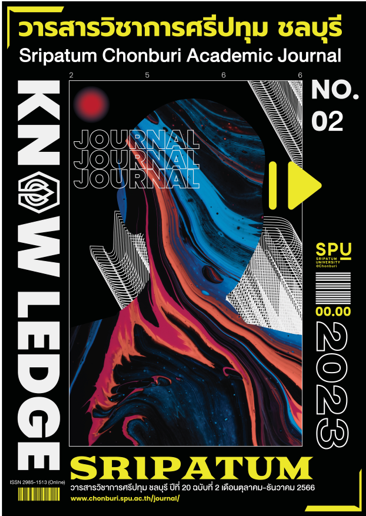A STUDY OF CREATIVE THINKING FOR INNOVATION FOR UNDERGRADUATE STUDENTS IN THE HOSPITALITY INDUSTRY IN CHONBURI PROVINCE
Keywords:
Students, Innovation, Hospitality IndustryAbstract
This research aimed to study the level of opinions and compare opinions about creative thinking to create innovation in each dimension of hats according to the Six Thinking Hats Theory for students in Hospitality Industry of higher education institutions in Chonburi Province. The sample group comprised 400 undergraduate students studying in fields associated with the Hospitality Industry in Chonburi Province. This research used multistage sampling method and the sample group of 20 undergraduate students in the Service Industry were selected for an interview. The research tools were an opinion questionnaire and semi-structured interviews, the quality of which had been checked. The statistics used to analyze the data included mean, standard deviation, one-way ANOVA, and multiple comparison tests using the Games-Howell method. In terms of the interview, content analysis was employed.
It was found that: 1) The students majoring in Hospitality Industry in Chonburi agreed that they had creative thinking for innovation in each dimension of Six Thinking Hats Theory as follows: In working on any subject, students would think about the reality that occurred (White Hat), always survey the needs or expectations of work first (Red Hat), always consider the disadvantages or weak points of work (Black Hat), consider the benefits of the results always work (Yellow Hat), consider the positive impact on the service industry (Green Hat), and always prioritize their ideas in their work (Blue Hat). 2) The students in the Hospitality Industry in Chonburi had a higher level of opinions on the dimensions of blue, green, and white hats than other hats. Therefore, organizations involved in the development of the students in this field should develop students in terms of studying customers’ opinions, needs, and preferences.
References
กมลรัตน์ เทอร์เนอร์, ลัดดา เหลืองรัตนมาศ, สราญ นิรันรัตน์, จิราภรณ์ จันทร์อารักษ์, บุญเตือน วัฒนกุล, และทุติยรัตน์ รื่นเริง. (2558). ทักษะแห่งศตวรรษที่ 21
ของนักศึกษาพยาบาลในวิทยาลัยพยาบาลบรมราชชนนี ชลบุรี. วารสารพยาบาลกระทรวงสาธารณสุข, 25(2), หน้า 178-193.
ชัชพล ทรงสุนทรวงศ์. (2559). นวัตกรรมการบริการ : กลยุทธ์ที่สร้างความได้เปรียบทางการแข่งขันขององค์การธุรกิจบริการ. วารสารการจัดการสมัยใหม่, 14(2),
หน้า 13-24.
ชูศรีวงศ์รัตนะ. (2553). เทคนิคการใช้สถิติเพื่อการวิจัย. กรุงเทพฯ: เทพเนรมิตการพิมพ์.
นัยนา รัตนสุวรรณชาติ, เขมมารี รักษ์ชูชีพ และศิรภัสสรศ์ วงศ์ทองดี. (2562). นวัตกรรมการจัดการ. วารสารการเมือง การบริหาร และกฏหมาย, 11(3),
หน้า 543-554.
พิชญาพร พีรพันธุ์, วิโรจน์ เจษฎาลักษณ์ และธนินท์รัฐ รัตนพงศ์ภิญโญ. (2566). กรอบแนวคิดศักยภาพความคิดสร้างสรรค์เชิงนวัตกรรม : ปัจจัยเชิงสาเหตุ
และผลลัพธ์. วารสารวิชาการร้อยแก่นสาร, 8(2), หน้า 306-318.
วัชรวิชญ์ วิยาภรณ์. (2563). แนวทางการพัฒนาศักยภาพบุคลากรทางการท่องเที่ยวของนักศึกษา บัณฑิต นักวิชาการ และผู้ประกอบการด้านการท่องเที่ยว.
วารสาร มทร.อีสาน ฉบับมนุษยศาสตร์และสังคมศาสตร์, 7(1), หน้า 30-44.
สำนักงานคณะกรรมการพัฒนาการเศรษฐกิจและสังคมแห่งชาติ. (2560). แผนงานพัฒนาระเบียงเศรษฐกิจ ภาคตะวันออก (ออนไลน์). เข้าถึงได้จาก:
https://www.nesdc.go.th/ewt_dl_link.php?nid=6381 [2566, 18 สิงหาคม].
Cochran, W. G. (1977). Sampling techniques. New York: John Wiley & Sons.
De Bono, E. (2017). Six thinking hats. London: Penguin.
Downloads
Published
Issue
Section
License
Copyright (c) 2023 Sripatum Chonburi Academic Journal

This work is licensed under a Creative Commons Attribution-NonCommercial-NoDerivatives 4.0 International License.
บทความทุกบทความเป็นลิขสิทธิ์ของวารสารวิชาการศรีปทุม ชลบุรี



